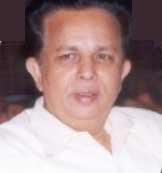Manned mission by 2012 - astronaut training facility at Bangalore: Madhavan Nair
25 Oct 2008
Bangalore: Indian Space Research Organisation (ISRO) chairman G Madhavan Nair has said that India's manned mission would take at least another three years. He also said that ISRO would build a major training facility for astronauts as well as a new satellite launch pad.
 The launch of the Chandrayaan-1 lunar mission marks a watershed in India's space programme, with an enhanced capacity Polar Satellite Launch Vehicle (PSLV-C11) dispatching the cuboid spacecraft on its path to the moon along with a Moon Impact Probe (MIP). The MIP, carrying the Indian flag, will make a landing on the moon's surface even as it conducts experiments on its way down.
The launch of the Chandrayaan-1 lunar mission marks a watershed in India's space programme, with an enhanced capacity Polar Satellite Launch Vehicle (PSLV-C11) dispatching the cuboid spacecraft on its path to the moon along with a Moon Impact Probe (MIP). The MIP, carrying the Indian flag, will make a landing on the moon's surface even as it conducts experiments on its way down.
According to the ISRO chairman, a manned mission in space is the logical development of the Chandrayaan programme and should be achievable by 2012. This, in turn, would be followed by a manned mission to the moon by 2020.
A preparatory mission to the manned landing on the moon would be the Chandrayaan-2, which will include a moon rover. The mission, a joint effort with Russia, is expected to be launched between 2010 and 2012.
Though permission for the manned missions is yet to be given, the Indian Government has already cleared the launch of Chandrayaan-2. However, the manned mission has been approved by the Space Commission, and a formal government approval may be forthcoming in the next few months.
As for the new launch pad, the third, at the Sriharikota spaceport Nair said the cost would be around Rs600 crore. He also said a major national facility for training astronauts would be established at Bangalore.
The manned mission involves development of a fully autonomous manned space vehicle to carry two astronauts into low earth orbit and back. The venture would require development of new technologies for the crew module, service module, launch escape system, establishment of long-term facilities and identifying detailed elements required for undertaking the venture.
"Basically, technology elements required for development of a habitable module is the top-most priority", Nair, also Secretary in the Department of Space, said.
"Technology elements required for improving the reliability of launch systems have been identified. Crew escape and mission management system has to be in place," he said.
According to ISRO estimates made in 2006, the cost for the manned space mission was Rs10,000 crore, spread over a period of eight years.
 "Looking at the global scenario and also our own priorities, we believe that undertaking a manned mission is very important and for that we are now conducting a basic study as to what technologies needs to be developed, what facilities needs to be established and how the reliability of launch system has to be improved and so on," Nair has said in an interview with a news agency.
"Looking at the global scenario and also our own priorities, we believe that undertaking a manned mission is very important and for that we are now conducting a basic study as to what technologies needs to be developed, what facilities needs to be established and how the reliability of launch system has to be improved and so on," Nair has said in an interview with a news agency.
"So this programme, once it is launched, of course it is very complex. We have to understand many fundamentals. The information available from literature is very little. So, with that our estimate is that it may take up to 2012, before we can have men around earth and back," Nair added.
An Indian Air Force pilot, Rakesh Sharma, made it to space aboard the Russian Soyuz rocket way back in 1984.
The Chandrayaan-I project has cost ISRO 80 million dollars, less than half of the Chinese and Japanese moon probes launched in 2007. ISRO expects the moon mission to lead to the generation of a larger chunk of the global space business.
"We have launched almost 16 satellites for other countries. It will show the reliability and confidence of PSLV system. I am sure more and more opportunities will come in the near future," Nair said.
India's space programme began in 1963. By now it has developed into a sophisticated enterprise, which develops its own satellites and launch vehicles and is barely dependant on overseas agencies for anything.






























